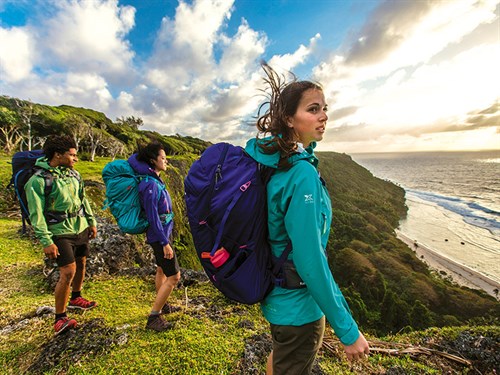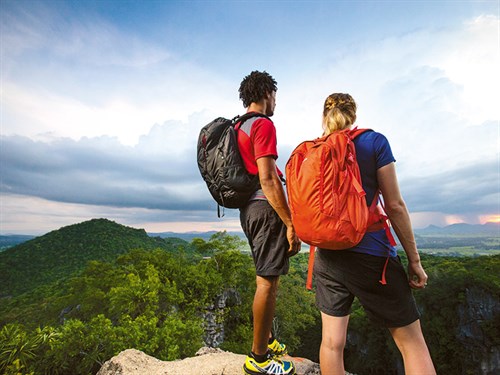
While it's natural to spend hours agonising over the configuration and features of your dream motorhome, once you've finally made the big decision and are out on the road enjoying what the country has to offer, the benefits don't begin and end at the side door.
Packing the right equipment to tackle the thousands of walking tracks New Zealand's out-of-the-way places offer should be as integral a part of your motorhome's contents as the bathrobes and bottle opener.
And with all manner of walking tracks, suited for beginner, intermediate and triathlete levels of fitness, as well as routes that take from 20 minutes to two days to complete, there's something somewhere for every hiker.
Even if you don't intend on walking far beyond the reaches of a decent flat white or fish and salad at the local cafe, you'll still enjoy your time on the tracks and trails with the right equipment.
But if exploring the country's walking trails is something you're keen to do on your next adventure into the hinterland, what do you take? Why are there so many different styles of back pack? And what do you fill them with (besides the obvious rain coat and sustenance)? What hiking shoes are best? Why is a specialised T-shirt for hiking better than that old Beefy T in the bottom drawer?
We asked Daan Dijkstra, Kathmandu's product information communication and training specialist for an expert insider's guide to the dos, don'ts and equipment essentials.
In your experience, what are some common mistakes or assumptions people make when setting out for a four or five hour hike?
One of the more common assumptions is that a short hike will be easy simply because it's short. However, depending on where you go, you can still run into some serious challenges on a relatively short walk. Taking a wrong turn and getting lost, an unfortunate run in with a rock, rolling an ankle, it's all possible – even on a short walk.
So no matter the length of the hike make sure you bring a map (and compass) and first aid kit to cover all bases. Also remember to take enough water and food, because even when it's 'only' a four-hour walk, it's no fun to be thirsty or hungry half the time.
What sort of route planning is ideal? How extensive should the group's/individual's knowledge of the track they're planning to take be?
It really depends on the difficulty of the track and the terrain, but you should always do some research beforehand so you know how long your planned hike is and what bottlenecks you might encounter. Make sure you inform somebody about your intentions so they can initiate help if you don't return as per plan. In most situations you won't have any cellphone reception. Always carry a map and compass (and know how to use them).
If you're going to invest a decent amount of money in one component of your tramping gear, what should it be?
It's very hard (if not impossible) to select one component; ultimately you want to enjoy your trip and to do so you need to be comfortable. Therefore you will need comfortable and specialised footwear, a pack that fits properly and a rain jacket that will keep you dry when the weather turns foul. Proper footwear is a good start though and should be one of the first focus points.
Aside from food, water and appropriate clothing, what are the essential items anyone setting out for a four or five hour tramp should have in their backpack?
Definitely a first aid kit to make sure you can attend to unexpected accidents immediately. A map and compass are essential too, especially if you are walking a more challenging track for the first time.

What are the benefits of using walking poles? Are these becoming more common in New Zealand?
Walking or trekking poles can give you more stability in difficult terrain (for example during river crossings). During steep descents they will reduce the impact on your knees and ankles, which will make it easier on your joints. On the flat or during the ascent of steep slopes they will allow you to use your arms to move forward faster. When wanting to use walking poles, we recommend the Kathmandu Fizan Escape AS (SRP $99.98), as it's the perfect anti-shock walking pole for all terrain, and compacts down to an easy transported length.
When it comes to selecting the ideal pack, there is an enormous amount of choice. What are some key features people should look for in a comfortable pack that can hold all they require?
Selecting a pack comes down to personal preferences and will depend on the type of trips you plan to go on. Comfort is again key, so you should always try on a pack before heading out on a big trip. No matter how pretty a pack is, if it isn't comfortable, you're not going to enjoy carrying it.
Another good rule is to take a pack that has the right capacity for your trip; a daypack should be less than 40L, anything bigger is usually more suitable for overnight or multiday trips. Remember, the less you carry, the more comfortable you'll be.
If you like to be super organised it helps to have a few different pockets on your pack; in the lid, on the sides or maybe even on the hipbelt for some small items you want easy access to. A great feature to have also is a raincover which keeps your gear dry. Some packs have a build in raincover, but if your pack of choice doesn't have this feature you can always buy a separate one.
Not all hiking boots are created equal. What are some key features to look for when selecting a good pair?
It's absolutely critical to buy hiking boots that fit your feet to experience maximum comfort. If you buy boots at Kathmandu, your feet will be measured and you'll be given the chance to walk around on them. Always try on boots wearing proper socks – the same socks you might wear while hiking.
How do specialised hiking tops differ from ordinary T-shirts?
Specialised hiking tops differ to normal tees in several ways. Firstly the fabric has a wicking finish to keep you dry and move moisture away from your skin quickly – dry means comfortable. The fabric also underwent an antibacterial treatment to stay fresh and odour-free for longer. The garments are engineered with trailTOUGH woven panelling on the shoulders, the lower back and on the hips for additional durability while carrying a pack. Finally the seamless shoulders reduce chafing.
What is the one necessary item most people overlook when kitting themselves out for a day tramp, or tramping in general?
Always make sure that you bring a small bag to put your rubbish in. That way you don't have to put your sticky orange peels and stuff straight in your bag. It's very important to carry out all your rubbish and leave nothing but footprints.
For the latest news and reviews, subscribe to Motorhomes, Caravans & Destinations magazine here.





